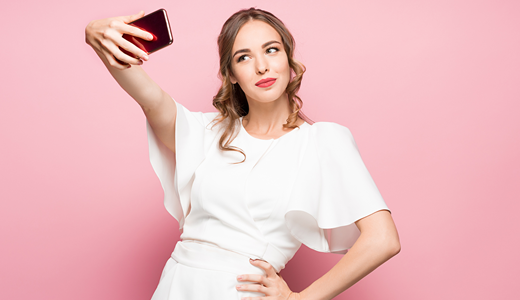We all probably have a favorite photo of ourselves—the one we use on our Facebook pages and Christmas cards, the one where the light was just right and our smile was just so and our hair was less unruly than it typically is. (Or, in the case of some of us, when we had hair at all.)
Thanks to technology, we can all push our photos into that realm of near-perfection. Services like Snapchat allow us to edit and filter our selfies to make us look oh-so-great. And some folks are wondering, why can’t I look like that all the time?
Plastic surgeons are seeing more and more people come through their doors toting their own perfect selfies, asking doctors not to make them look like Henry Cavill or Ariana Grande, but themselves—only better. It’s called “Snapchat dysmorphia,” and the periodical JAMA Facial Plastic Surgery is sounding an alarm over it, “because those filtered selfies often present an unattainable look and are blurring the line of reality and fantasy for these patients.”
Some are pushing back against that sense of dysmorphia, though, including journalist Katie Couric. She posted a less-than-perfect selfie—lying in bed in her pajamas without makeup, suffering a sore throat, to Instagram. “Clearly, I am bucking the trend,” she wrote in her caption.
‘Course, you don’t need to stare at those perfectly-filtered photos of yourself to develop problems. Just staring at a screen at all for too long has proven to be detrimental to children.
We’ve known for a while, of course, that children who spend too much time watching television, playing videogames and fiddling with smartphones are more apt to be overweight and have worse cardiovascular health. Now the American Heart Association has issued its official statement on the issue, telling the world that “daily device-free social interactions and outdoor play should be encouraged.” In addition, they suggest parents should “enforce appropriate screen time regulations and to model healthy screen-based behaviors.” (Judging from parents’ own dependence on smartphones, easier said than done.)
Many companies, including Facebook, Instagram and Apple, are rolling out measures to combat tech addiction. Some observers, though, remain unimpressed. “If one is addicted to maximizing ‘likes,’ it seems that these tools are a bit like suggesting to an alcoholic that he/she set an alarm to go off after the first drink or a few drinks—not effective at all,” says Patricia Greenfield, who teaches psychology at UCLA.
As for those tech companies themselves, some of them seem to be heading in different directions. While social media giant Facebook has taken a few rocks to the face—the cost of its shares sank by more than 20% recently—Apple has now become the world’s very first $1 trillion company. And some are now wondering whether the behemoth is too big to fail.
Who else may be failing? Well, according to Southern California’s Annenberg Inclusion Initiative, the movie industry is: Its latest annual study found that movies are still predominantly fronted by white, heterosexual men. Despite such high-profile, woman-fronted films such as Star Wars: The Last Jedi, Wonder Woman and Beauty and the Beast, only 33% of 2017’s top films starred or co-starred a woman, and only 29.3 percent of speaking characters were, in Entertainment Weekly’s words, “from an underrepresented racial group,” noting that 38.7% of the U.S. population is part of such groups.
“Representation of LGBT characters was especially dismal,” Entertainment Weekly continues. “Eighty-one of last year’s top 100 films had zero gay, lesbian, or bisexual characters, and not a single film had a transgender character.”
Plenty of folks in Hollywood are aiming to change that last little statistical nugget, of course. A trailer just dropped for Chloë Sevigny and and Kristen Stewart’s new film, Lizzy, suggesting that the infamous Lizzie Borden (allegedly) picked up her hatchet because … she was a lesbian, I guess. And the CW recently announced that Ruby Rose will play the lesbian superhero Batwoman in its “Arrowverse” (an umbrella term for the network’s large stable of D.C.-centric superhero shows, of which Arrow was the first) likely fronting her own series beginning in 2019.
To wrap things up, let’s turn our attention to the world of real estate, shall we? When an ever-so-hip 1970s California suburban property—best known as the house that served as the home for The Brady Bunch—went up for sale recently, some worried that the iconic house might be torn down. Former NSYNC member Lance Bass tried to buy and save the property, only to find that he was outbid, leaving him feeling “heartbroken.” But when he learned that HGTV bought the house and promised that “we’ll restore the home to its 1970s glory as only HGTV can,” all was fine in Bass’ world. “I can smile again,” he wrote on Twitter.
No word on the winning bid, but Zillow estimated the house was worth a cool $1.9 million.
What? Why, you can buy a whole Game of Thrones castle for about a third of that. No word whether dragons come with the property, though.






Recent Comments